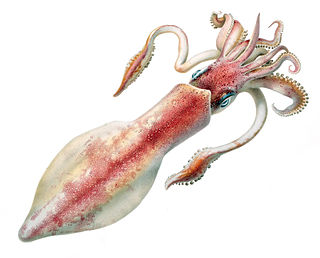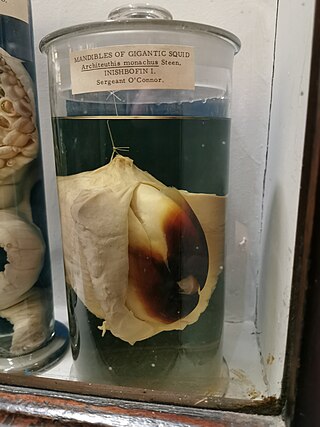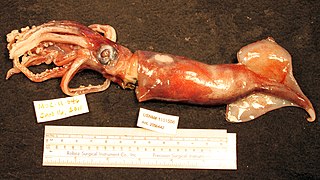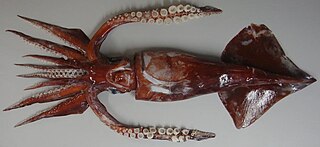
Ommastrephidae is a family of squid containing three subfamilies, 11 genera, and over 20 species. They are widely distributed globally and are extensively fished for food. One species, Todarodes pacificus, comprised around half of the world's cephalopod catch annually.

Onykia robusta, also known as the robust clubhook squid and often cited by the older name Moroteuthis robusta, is a species of squid in the family Onychoteuthidae. Reaching a mantle length of 2 m (6.6 ft) it is the largest member of its family and one of the largest of all cephalopods. The largest specimen with reliable catch data was found in the Bering Sea, a male with a total length of 3.72 m (12.2 ft) and weighing 41.73 kg (92.0 lb). The tentacular clubs are slender, containing 15–18 club hooks. Arms of the species contain 50–60 suckers, and grow to 90–100% of the mantle length. It is found primarily in the boreal to Temperate Northern Pacific.

Onychoteuthis banksii, the common clubhook squid, is a species of squid in the family Onychoteuthidae. It is the type species of the genus Onychoteuthis. This species was thought to have a worldwide distribution but with the revision of the genus Onychoteuthis in 2010, it is now accepted that Onychoteuthis banksii is restricted to the central and northern Atlantic and the Gulf of Mexico while a recently described species, Onychoteuthis horstkottei, is found in the Pacific Ocean. The type locality is the Gulf of Guinea.

Xipholeptos is a genus of squid in the family Idiosepiidae. It is monotypic, being represented by the single species Xipholeptos notoides, commonly known as the southern pygmy squid. The species was originally classified as Idiosepius notoides. The southern pygmy squid is native to the southwestern Pacific Ocean, off southern and eastern Australia. It inhabits shallow, inshore waters. It has been recorded off the coasts of New South Wales, South Australia, Tasmania and Victoria.
Moroteuthopsis longimana, also known as Kondakovia longimana, the giant warty squid or longarm octopus squid, is a large species of hooked squid. It attains a mantle length of at least 85 cm and probably over 1.15 m. The largest complete specimen of this species, measuring 2.3 m in total length, was found in Antarctica in 2000.

Loligo forbesii, known commonly as the veined squid and long-finned squid, is a commercially important species of squid in the family Loliginidae, the pencil squids.

Todarodinae is a squid subfamily in the family Ommastrephidae.

Martialia hyadesii is a species of flying squid commonly known as the sevenstar flying squid. They have a maximum mantle length of 400mm, with a body weighing 820g.

All extant cephalopods have a two-part beak, or rostrum, situated in the buccal mass and surrounded by the muscular head appendages. The dorsal (upper) mandible fits into the ventral (lower) mandible and together they function in a scissor-like fashion. The beak may also be referred to as the mandibles or jaws. These beaks are different from bird beaks because they crush bone while most bird beaks do not.

Illex coindetii, commonly known as the southern shortfin squid or broadtail shortfin squid, is a species of neritic squids in the family Ommastrephidae. They are found in the Mediterranean Sea and on both sides of the north Atlantic Ocean.

Illex illecebrosus, commonly known as the northern shortfin squid, is a species of neritic squids in the family Ommastrephidae. Squids of the genus Illex account for 65% of the world's cephalopod captures. Illex is formed by four taxa distributed throughout the Atlantic Ocean, whose identification and phylogenetic relationships based on morphological characters remain controversial.They are found in the northwest Atlantic Ocean, from off the coast of eastern North America to Greenland, Iceland, and west of Ireland and the United Kingdom. They are a highly migratory and short-lived species, with lifespans of less than a year. They are commercially important and are fished extensively, mostly for the Canadian and Japanese markets.

Illex oxygonius, commonly known as the sharptail shortfin squid, is a species of neritic squids in the family Ommastrephidae. Of the species of the genus Illex, they have the most restricted range, being found only in the western North Atlantic Ocean; from off New Jersey, south to the Straits of Florida and into the Gulf of Mexico. They are very difficult to distinguish from Illex coindetii and Illex illecebrosus, with which their geographic range overlaps. The most obvious difference of I. oxygnius is their sharper fin angles of 25° to 40°. There is also the possibility that they may be a hybrid of I. coindetii and I. illecebrosus.

Pinnoctopus cordiformis is a species of octopus found around the coasts of New Zealand. It is one of the most common species of octopus in the country.

The purpleback flying squid or purpleback squid is a species of cephalopod in the family Ommastrephidae, occurring in the Indo-Pacific. It is considered one of the most abundant large squids.

Ornithoteuthis antillarum, the Atlantic bird squid, is a species of flying squid from the family Ommastrephidae which is found in the warmer waters of the Atlantic Ocean. This species is an important component of the diet of many species of fish and of cetaceans. It is taken as a bycatch in fisheries but has the potential to be commercially important if appropriate fishing methods can be developed.
Ornithoteuthis volatilis, the shiny bird squid, is a squid from the subfamily Ommastrephinae, the flying squids, of the family Ommastrephidae part of the pelagic squid order Oegopsida. It is a tropical and sub-tropical species which is widely distributed in the Indo-Pacific oceans. It is slightly larger than the closely related species Ornithoteuthis antillarum of the Atlantic Ocean.
The Angolan flying squid is a species of squid from the subfamily Todarodinae, part of the family Ommastrephidae. Due to taxonomic confusion with the Antarctic flying squid the exact limits of its distribution are uncertain but it is thought to be restricted to waters off Southern Africa.

The Antarctic flying squid is a species of squid from the subfamily Todarodinae of the family Ommastrephidae, a family of pelagic squid from the order Oegopsida. It has a circumglobal distribution in the seas around the lower latitudes of the Southern Ocean.
The little flying squid is a species of squid, one of the arrow squids of the genus Todarodes, in the subfamily Todarodinae of the flying squid family Ommastrephidae. It is a small species from the waters around northern Australia and Indonesia.

The European flying squid is a species of squid from the continental slope and oceanic waters of the eastern Atlantic Ocean and the Mediterranean Sea. It is the type species of the genus Todarodes, the type genus of the subfamily Todarodinae of the pelagic squid family Ommastrephidae. It is a species which is targeted by some fisheries, although it is more often a bycatch.

















